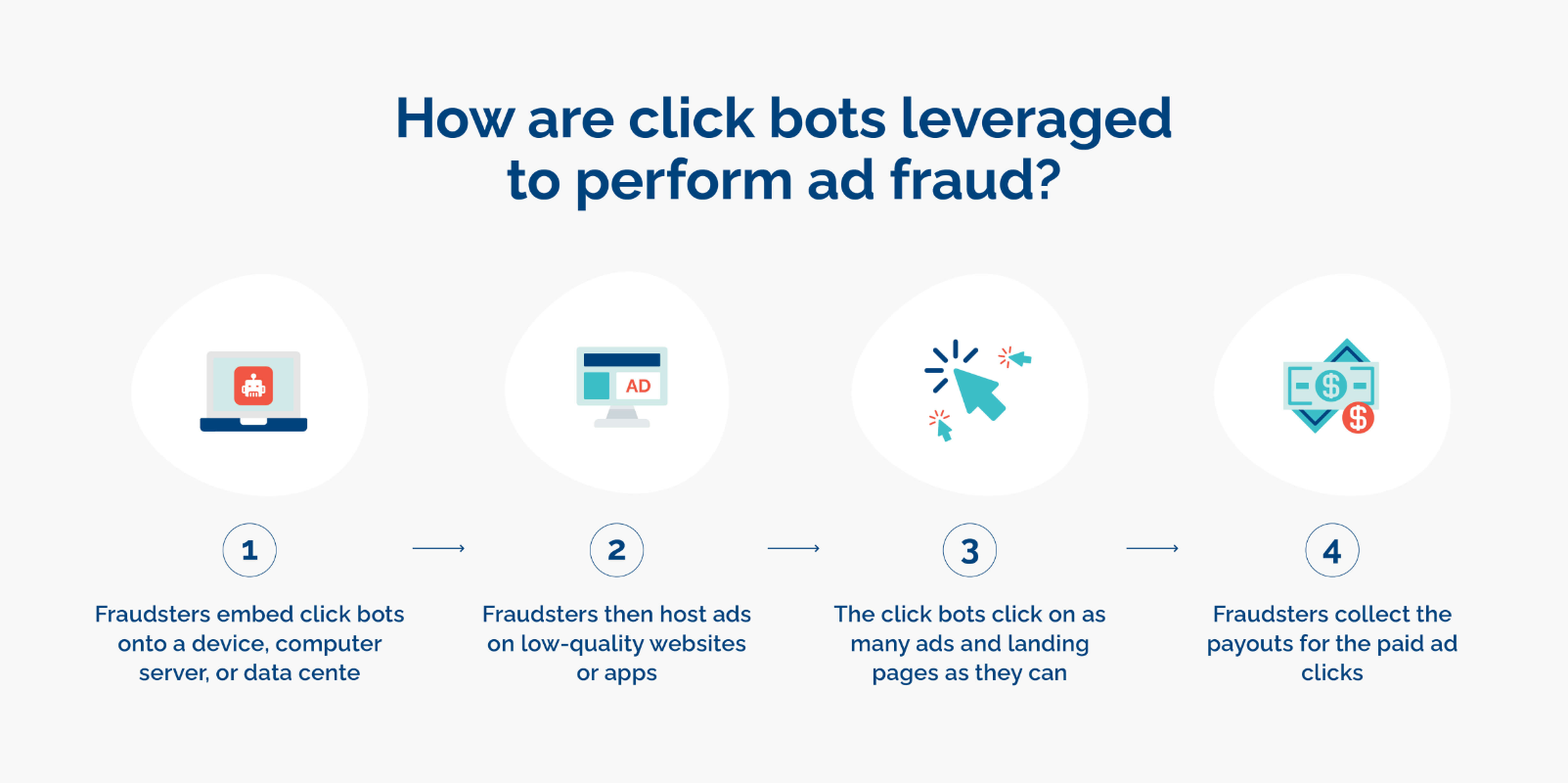Invalid traffic is a huge problem for marketers. Click fraud is a significant driver of this type of traffic, and it occurs when invalid or illegitimate clicks are made by malicious software, bots, or competitors. Click fraud is carried out using various techniques such as clickjacking, click spamming, click injections, and click bots.
When it comes to ad fraud, understanding the types of ad fraud you’re up against is essential to preventing them.
Click bots are just one of the many vehicles fraudsters use to exploit pay-per-click (PPC) campaigns. But as click bots become more sophisticated, other ad campaigns using different revenue models are also being targeted.
Read on to discover:
- What click bots are and what they do
- The differences between good and bad click bots
- How click bots work
- The actors behind click bots
- The threats click bots pose to your campaigns
- How to prevent click bots from destroying your campaigns
What are click bots?
Click bots are a distinct type of bot designed with a specific task to perform — to execute clicks on desirable links. Within the context of the PPC advertising model, for example, click bots have been coded to click on PPC ads.
These bots can perform repetitive tasks very quickly and are becoming more automated and increasingly sophisticated. Some of the most advanced click bots can mimic the nuances of human behavior to avoid detection, including pausing, lingering on a web page, and performing certain mouse movements.
What’s more is that instead of operating on a single device (which would instantly rouse suspicion), click bots work within botnets, which are networks of thousands of devices with different IP addresses. This means that every time a click bot fraudulently clicks on your ads, you’re wasting your budget on clicks that will never convert.
What are the differences between good click bots and bad click bots?
Even though the word ‘bot’ can have negative connotations, there are actually good click bots operating all over the internet. Moreover, good bots often have many of the same characteristics as bad bots, so knowing the difference between the two is essential.
Good click bots
Good click bots can be an incredibly useful tool for both marketers and businesses since they enable you to automate and speed up several repetitive processes.
For example:
- Good click bots can click every link in an email before it’s delivered to its recipients, as a way to protect them from spam or malware.
- Good click bots can monitor websites insofar as clicking all published links to check that they’re functional.
Malicious click bots
Bad click bots are in no way useful for marketers and businesses, and, gone unnoticed, they can decimate ad campaigns. Since these bots carefully imitate human behavior, they can perform increasingly complex “tasks”.
For example:
- Bad click bots can click on your paid ads.
- Bad click bots can also browse websites, add items to shopping carts, complete forms and downloads, and click on links.
- Networks of botnets that leverage click bots can infect user devices and leverage them to carry out fraudulent clicks at an alarming rate.
Given the advanced level of today’s click bots, most of their activity goes unnoticed by the everyday marketer or advertiser. This means that click bots represent a massive threat to your ad budgets and, therefore, the success of your campaigns.
How do click bots work?
Let’s look at how fraudsters can leverage click bots to perform this type of ad fraud.
1. Fraudsters embed click bots onto a device, computer server, or data center2. Next, they host ads on low-quality websites or apps owned by them.
3. The bots then click on as many ads and landing pages as possible. With ad campaigns often running for several months, they can easily and quickly rack up thousands of clicks. Each of these costs money to the advertiser who believes they’re paying for real clicks.
4. Fraudsters then collect the payout for the paid-ad clicks.

Who’s hiding behind bad click bots?
Click bots are very easy to create and use, and anyone with a coding background can produce one. In fact, bots account for 40% of the traffic on the internet, making them one of the most common types of ad fraud.
Just like most types of ad fraud, click bots are employed by several different actors — and none of them have good intentions.
Your ad publishers and affiliates
Ad publishers and affiliates use click bots to boost traffic numbers and increase their revenue. They do this to collect the payouts for the clicks on the ads. This is common in ads using the PPC revenue model. The more organized and sophisticated they are (e.g., running a wider network), the more dangerous they are to your campaigns.
Your competitors
Some competitors aren’t above using click bots to repeatedly click on your ads and drain your budgets, knowing that you won’t see a return on investment. This is particularly common in highly competitive ad markets and should not be underestimated — it can significantly impact your campaigns, especially those with keywords with a high cost-per-click (CPC).
Random bot operators
Fraudsters anywhere in the world can create and use click bots to randomly target ad campaigns (display, video, search results, etc.), and are common users of click bots.
Why are click bots so bad for your ads?
Click bots, like any type of ad fraud, pose considerable threats to your ad campaigns. PPC campaigns, in particular, are highly prone to click bot activity.
However, although click bots are usually associated with SEM, PPC, mobile ads, and affiliate marketing, they’re not limited to these channels — which means that all marketers with online ads should care about click bots.
Every fake click wastes your ad budget, and with click bots able to perform unlimited clicks, budgetary losses are a huge concern for marketers and advertisers. However, as well as wasted budgets, you’ll also experience many other negative impacts when click bots target your campaigns.
Here, we take a look at the spectrum of damage caused by click bots if you don’t actively prevent them from attacking your ad campaigns.
Skewed analytics and botched decision-making
Most businesses naturally assess advertising channels based on the traffic and engagement they bring. From this analysis, they strategically invest in those that welcome the most traffic. When the traffic and clicks are fake, however, they’re throwing ad spend down the drain with no chance to reinvest it.
Plus, fake clicks skew your analytics, which are essential for directing your strategy. When you can detect click bots before they have a chance to ruin your campaigns, you also protect the integrity of your data, better understand your performance, and are more able to assess the behavior of your real audience.
Finally, since click bots can closely resemble human behavior, including clicking download forms and booking meetings, you’ll receive fake leads — further scuppering your analytics.
Detecting bad click bots enables you to maintain the accuracy of your analytics results as well as your website’s performance.
Bad retargeting efforts
When you’re unable to identify clicks deriving from click bots while you’re conducting retargeting campaigns, you’ll also continue to retarget this fake audience.
This means that not only are you wasting ad budget from fake clicks, but you’re also directly retargeting the same click bots. All of this adds up to a large chunk of wasted ad budget that will not create any return whatsoever.
💡 Did you know? Google Ads also has a strict policy to identify invalid clicks, but since certain click bots are so sophisticated, the tech giant can’t actually identify them all. In fact, automated clicks generated by bots/software are so advanced that they are extremely similar to human clicks and are, therefore, hard to detect. Google cannot remove or block every instance of click fraud, and even if they could, new ones would still keep appearing.
How can you protect your campaigns against click bots?
Click bots have evolved to the point where they’ve reached a level of sophistication that requires equally advanced solutions to fight it. Here are some of the options that marketers have available to prevent click bots from ruining their campaigns.
Create your own in-house methods
While it’s possible for your IT teams to monitor and minimize click bot activity, it’s important to remember that these types of manual actions are highly time-consuming and costly. And more often than not, they won’t be able to detect all instances of ad fraud.
Here are some of the in-house methods used to detect early signs of click bot activity.
- Traffic monitoring: Monitoring your traffic daily and checking for inconsistent or unexplained trends and peaks (volume, location, high CTR rate but low conversion rate, etc.) can help you identify click bots. With Google Analytics, you can check key metrics such as bounce rate and average session duration, which indicate the presence of bots. But this method also identifies good bot activity.
- Establish IP exclusion lists: If you notice an uptick in clicks deriving from particular traffic sources or countries, click bots may well be at play. For example, if your campaigns are Europe-focused and you start receiving clicks from Southeast Asia, click bots or click farms are likely behind them.
- Refine your targeting: The broader your target, the more likely you are to attract different click bots. When you carefully select the regions/countries you want to focus on, you can, in some instances, minimize the chances that click bots will target your ads.
- Don’t run ads 24/7: Since fraudsters work on a 24/7 basis, limiting the availability of your ads also reduces their exposure to fraud. When ads are run outside of your time zone, they’ll be more likely to attract click bots from other geographies.
- Check where your ads are displayed: You can check the quality of the websites and apps where your ads are displayed. Poor-quality sites with large amounts of banners and pop-ups are probably websites designed specifically for ad fraud.
Invest in dedicated anti-ad fraud software
Creating your own solutions to detect click bots is time-consuming and a drain on resources. Plus, these methods are nowhere near as advanced as dedicated software solutions.
While you may be able to detect click bots with the methods above, you cannot anticipate nor prevent them before they impact your campaigns. This is only possible with specialized anti-ad fraud solutions that detect and prevent ad fraud.
The easiest, safest, and most effective way to prevent click bots is with an anti-ad fraud solution that enables you to:
- Identify where click bots are coming from (channels, sources, keywords, etc.).
- Monitor your traffic to automatically detect and prevent fraud before it can impact your ad campaigns.
- Target and retarget only real leads based on valid clicks and optimize your campaign budgets.
- Collect reliable analytics and ensure you’re making informed decisions based only on real and valid clicks.
Get rid of click bots with a dedicated anti-ad fraud solution
Opticks is a cross-channel and full-funnel anti-ad fraud solution that detects and prevents click bots across all channels and at any point in the advertising funnel.
Our holistic solution is dedicated to preventing fraudsters from destroying your ad campaigns, draining your budgets, and ruining your retargeting efforts.
To learn more about how the expert team at Opticks can prevent click bots before they have a chance to decimate your campaigns, contact us now.
